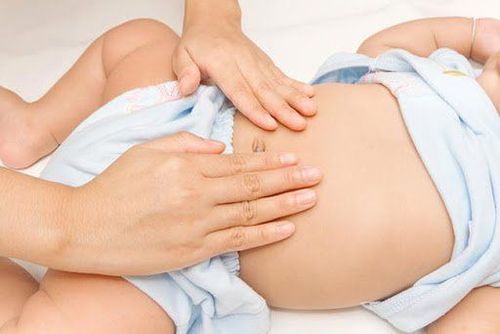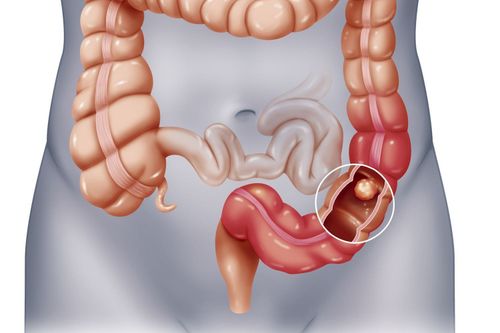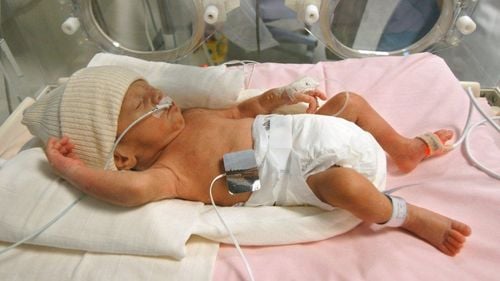This is an automatically translated article.
Esophageal atrophy or gastrointestinal atrophy is a rare congenital malformation of the gastrointestinal tract. When the esophagus is atrophied, it will lead to many dangerous consequences and complications, if not treated promptly, it can lead to death. Therefore, it is necessary to detect and treat early to avoid the danger to the fetus.
1. Overview of esophageal atrophy
Esophageal atrophy is essentially a disruption of esophageal circulation, accompanied by an abnormality in circulation between the esophagus and the trachea. Esophageal atrophy is also a consequence of disturbances in embryogenesis between the 4th and 6th weeks of pregnancy.
When the embryo is formed, the trachea develops from the mesoderm of the first embryo at 4 weeks of gestation. From the tracheal wall is separated into the esophagus, if this membrane is not completely separated between the trachea and esophagus, it will cause esophageal atrophy with or without fistulas of trachea and esophagus.
Thus, atrophy of the esophagus leads to incomplete formation of the esophagus, often associated with tracheoesophageal fistula. The estimated incidence of esophageal atrophy is 1/5000 cases, in which it is often accompanied by other multiple malformations, so it is also called VACTERL syndrome with abnormalities in organs such as heart, spine, genitals, and urinary tract. urinary, digestive, or malformations of the hands and feet.
2. Symptoms of esophageal atrophy
Signs and symptoms of children with esophageal atrophy often appear very soon, right after birth. When having esophageal atrophy, children often have the following symptoms:
Respiratory system disorders: Children with rapid, shallow breathing, difficulty breathing. Increased salivation causes secretions to come out of the airways: This symptom is also known as "crab foam". This is an early sign and is often the only symptom, the discharge is sometimes pink and can cause airway obstruction. Gastrointestinal disorders: Poor suckling, may be accompanied by coughing or vomiting when feeding. Children with abdominal distension due to gas in the stomach or vice versa. Causes pneumonia with symptoms such as cough, difficulty breathing, cyanosis due to aspiration after eating or from secretions that leak into the trachea and bronchi. Early detection of symptoms of esophageal atrophy will help children avoid the risk of bowel necrosis and life-threatening complications.

Teo thực quản có thể xuất hiện tình trạng chướng bụng
3. Diagnosis of esophageal atrophy in neonates
Diagnosis of gastrointestinal atrophy is made as follows:
Prenatal diagnosis: Usually done by ultrasound, however, direct imaging is almost absent, so the diagnosis is mainly based on imaging indirectly through the mother with polyhydramnios, the stomach cannot be clearly seen, or other congenital anomalies are detected. Clinical diagnosis is based on the following signs: The child coughs or chokes while suckling The child has respiratory failure Appearance of signs of foaming Crab Inability to insert a nasogastric tube Pneumonia Some malformations are seen other attached. X-ray: Chest X-ray Contrast X-ray of the esophagus. Based on the classification of esophageal atrophy n by Ladd and Gross in 1953, it will help doctors diagnose and provide better treatment and prognosis for each patient as follows: + Type A: Esophageal atrophy no probe (8%).
+ Type B: Atrophic esophagus with proximal esophageal-tracheal fistula, superior fistula (<1%). According to histopathology, this type includes esophagogastric pouch at both ends but with an additional tracheoesophageal fistula at the upper end.
+ Type C: Gastrointestinal atrophy with distal esophageal-tracheal fistula, lower segment fistula (86%). This form is usually characterized by an obturator at the upper end and a tracheoesophageal fistula at the lower end.
+ Type D: Atrophy of the gastrointestinal tract with esophageal-tracheal fistula, double fistula (< 1%)
+ Type E: Esophageal-tracheal fistula without atrophy (also known as H-type fistula) (4%)
+ Type F: Esophageal stricture (<1%).
4. Treatment of esophageal atrophy in children
When children have esophageal atresia, the most common and effective method of treatment is surgery. Depending on the patient's condition, the doctor will perform the appropriate type of surgery. The general purpose of surgery is to cut and suture the tracheoesophageal fistula (if any).
Doctors will perform surgery by stitching the two ends of the esophagus together if the child has atrophy of the digestive tract with a slight gap. This will help clear the digestive tract from the mouth to the stomach again.

Điều trị bệnh teo thực quản ở trẻ bằng phương pháp phẫu thuật
As for the cases of esophageal atrophy, the distance is too large. The doctor will perform surgery by taking a piece of intestine up and connecting it to the esophagus. Or you can bring the upper end of the esophagus to the neck, then open the stomach to let the baby eat. After that, the patient will be performed esophagectomy after 6 months.
Esophageal atrophy is a rare but very dangerous disease and can have many bad complications. Therefore, timely detection and treatment of esophageal atrophy in neonates is extremely important to avoid the risk of death. Pregnancy check-ups for early detection to perform surgery will help avoid the risk of dangerous complications for the baby.
At Vinmec International General Hospital, there is a package maternity service as a solution to help pregnant women feel secure because of the companionship of the medical team throughout the pregnancy. When choosing Maternity Package, pregnant women can:
The pregnancy process is monitored by a team of qualified doctors Regular check-ups, early detection of abnormal problems Maternity package helps to facilitate the process of pregnancy. birthing process Newborns receive comprehensive care.
Please dial HOTLINE for more information or register for an appointment HERE. Download MyVinmec app to make appointments faster and to manage your bookings easily.













